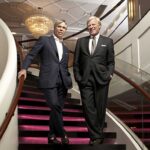In 2002, as email and Internet use were rapidly growing, Ryan Buchanan, a former financial analyst for Intel, saw opportunity in the nascent field of digital marketing. “There was this whole revolution going on with dot-coms and all this innovation happening and all these people striking it big,” says Buchanan, the founder and CEO of eROI Inc. in Portland, Ore.
Within just a few years, Buchanan’s startup became one of the Portland area’s go-to digital marketing agencies, thanks to its winning combination of creative services and email marketing technology, which helps clients build, send and track results from promotional emails. Revenues climbed from $350,000 the first year to $4 million in 2007—the year the company made Inc. magazine’s list of the 500 fastest-growing companies; it hit $4.8 million in 2008.
Striking it big seemed like a real possibility.
But Buchanan learned that rapid growth and forays into new ventures can take costly, unexpected detours. His move to develop eROI’s own email software platform, rather than continue using other companies’ products, nearly sank the company, resulting in layoffs and the loss of $1.5 million. “I went through a lot of pain to get to a place that was stable,” he says.
His company is again growing—with a forecast of $4.6 million in business this year—and the entrepreneur can now look back on his mistakes and the lessons he learned from the challenges of the past few years.
Meteoric Growth… at First
Early on, it was clear to Buchanan that he had found an important niche in email marketing by working for mostly small- to medium-sized client companies that did not have their own staffs to create and design content for brand campaigns. In addition, he impressed clients by providing real-time tracking of customers’ responses to email marketing campaigns. They could immediately observe what worked and what didn’t by watching what people were clicking on or skipping in emails precisely when they acted—a huge advance from trying to keep track of customer response to old-fashioned direct mail. “We were able to bring on a lot of new clients; at one time we were bringing on eight clients a month,” Buchanan says.
And eROI landed small gigs with large, well-known companies, too. “We were… doing small projects for Microsoft, Wal-Mart and Cingular Wireless [now AT&T Mobility]. It was really helpful” that eROI staffers could name-drop these big clients during its sales and marketing conversations.
In 2008, the company employed nearly 50 people, and revenue continued to rise. That’s when Buchanan decided to stop licensing other companies’ software and have eROI develop its own. “It’s a very scalable, high-margin business,” he says. “In theory, we had all the momentum to do that. We had 350 clients at the time, and we thought that if we built world-class software, we could migrate clients over to it.”
The company funded the development project for two years, and then angel investors including friends and family put in $450,000. But the product, called Switchbox, never got traction during a sour economy as marketing budgets were being universally slashed. “Long story short is that after three years, on Dec. 2, 2010, I pulled the plug and had to write off $1.5 million,” Buchanan says. “We really had to go back to our roots as a digital campaign agency.”
Takeaways
And that was one of the most important lessons he learned: Focus on your strengths and what you know.
For Buchanan, that meant shifting the company’s energies back to client work and investing in his remaining staff, which had dwindled to about 14 people. “Our culture is very strong, and we now invest a lot in people again. When we were doing our software investing, it was taking funds away from people.”
The other big lesson was to concentrate on building long-term clients rather than quick-hit business. “Instead of one-and-done projects, we are now all about forming long-term strategic partnerships in which we work collaboratively. One of the best examples is Nike’s digital commerce team. We have six employees embedded full time on-site with them.”
Buchanan also credits the Entrepreneurs’ Organization with helping transform his business and way of thinking when he joined two years ago: “I brought my whole executive team into the EO fold to adopt a goal-setting and strategic planning framework called Rockefeller Habits, which brought goals into alignment throughout the company. We doubled our revenue in those two years. Secondly, my EO Forum of seven inspiring peer entrepreneurs, whom I meet with every month for four hours at a time, have shared experiences and resources that have helped me improve and free up more time to be a better husband and father, and to simply enjoy life more. It’s been a major factor in eROI’s current path to sustained success.”
Buchanan now emphasizes long-term growth. “It’s difficult to be on a path where investors and others are urging you to go faster and faster with insane growth and an exit [selling the company] in five to seven years. By following the other path of organically growing a profitable business that you don’t have to sell in a short period of time, the chances of your success go up dramatically.”
He says the necessary shift in thinking is a dramatic one. “You have to redefine your idea of success so that maybe when you do sell your company, it will take 10, 20 or even 30 years. But you’re going to be pretty profitable along the way and enjoy the ride instead of sprint, sprint, sprinting the whole way. There are very few people who can sprint a marathon.”
Ryan Buchanan offers these lessons to other entrepreneurs:
• Create a separate company to develop new products such as software so the new enterprise is detached from your core operation. With an independent entity, you can reward employees with equity and cash while preserving your control over, and equity in, the original company. When you hire for this new company, seek talent specific to product development.
• Set reasonable and realistic goals. “Be careful who your heroes are. [Don’t] get really absorbed in the ego of ‘I have these friends who have sold their software business for $100 million.’ Instead you need to really look at what your core strengths are as an entrepreneur and play to them instead of aspiring to be like your supposed heroes.”
• Innovate within your own niche. “Don’t try to start new services, but go deeper into your own business. Pick just one niche of the market. It’s a better strategy than trying to dethrone the multiple entrenched players in a mature market.”
• Invest in your people. “Have employees buy into what they’re doing. Invest in people from a personal development perspective. Work well as a team.”









